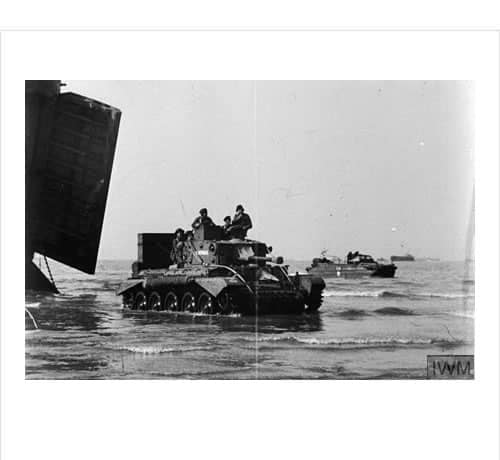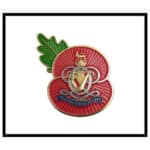It is as well, before the actual landings were made, to describe briefly what manner of country and defences awaited the 7th Armoured Division, and what was to be the general plan of attack.
The coast chosen for the invasion was a stretch between the rivers Orne and Vire, and the first task of the invading armies was to gain a bridgehead that included Caen and Bayeux. The plan was to land on a front of some thirty miles, protected by the airborne troops who would have already landed and established themselves.
The American 1st Army, under Lt Gen Bradley, would make for the crossings over the Vire and push on to Cherbourg, while the British 2nd Army on the left, consisting of two corps under Lt Gen Sir Miles Dempsey, would secure the crossings over the Orne and the roads to Bayeux and Caen.
On the right hand of this assault was to be Lt Gen G.C. Bucknall’s 30 Corps, coming in over the Arromanches and Le Hamel beaches with the 50th Division in the van, followed by the 7th Armoured and 49th Divisions in that order.
After landing, the attackers were to find two entirely different types of country awaiting them. After a strip of open marshy ground, that stretched inland for some few hundred yards from the beaches, the ‘bocage’ started.
From the air, this looked like one continuous wood but it was, in reality, small fields surrounded by high-banked hedges of pollarded trees, orchards and a network of narrow muddy tracks, so over-hung with gorse and broom and hazel that they were almost tunnels.
This extended west and south of Bayeux and was hopeless for tanks or even artillery. The chief landmark here was Mont Pincon, some ten miles south of Villers Bocage, the highest feature of a range of wooded hills. To the south and south-east of Caen the country was quite different, the ‘Campagne’, open rolling plain, all arable. broken by wooded valleys.
The enemy forces in this area were the 7th and 15th Armies, commanded by the Desert Rats’ old opponent, Field-Marshal Rommel. The coastline, protected by an immense amount of wire, mines, concrete blocks and other obstacles, was held by a second-grade infantry division, and behind them, southwest of Bayeux, the 352nd infantry division.
At Falaise and Bernay were the 12th S.S. and 21st Panzer Divisions, with two more, the 17th S.S. and 2nd Panzer within easy reach. These four divisions were equipped with Panther and Tiger Tanks, both heavier armed and more heavily armoured than our tanks, and which, although less manoeuvrable, were well suited for the defensive fighting ahead.
By May 28th, in Bognor, all plans were completed. Officers were briefed and camps were sealed. There was now no more to do but wait, as all armadas have done, for favourable winds and tides.
On June 3rd., came orders to move the next day to their Marshalling Area. Lt Col Goulburn spoke to each squadron in turn and told them the points stressed by General Montgomery in his final address to Unit Commanders.
The move was postponed for a day, but on June 5th the 8th Hussars, less ‘C’ Squadron, moved off at 2.30 p.m. It was a necessarily slow journey, all the roads in the south were at a crawl with transport heading for the coast, and it was not until 9.45 that night that they arrived at Havant.
All tanks and ‘D’ vehicles were parked by craft-loads in roadside standings. Eleven L.C.T.’s had been allotted to the Regiment on the scale of one per nine tanks or twelve ‘B’ vehicles.
The next day was D-Day. June 6th. Maps were drawn and issued, and orders were received to move on the morning of the 7th. Lt Col Goulburn gave a final briefing to officers and tank commanders. Last letters were written home. The feeling of unreality deepened. They watched the Airborne troops going over, and knew that it could not be long now.
There was, however, one more delay, but on June 8th, the first craft load rumbled out of the Marshalling Area at 1.30 in the morning, followed at five-minute intervals by the remaining parties. Having arrived at Gosport they parked by the sides of various roads leading to the hards, and everyone appeared to be happy, singing and shouting and waving.
Embarkation began at about 2 pm. and as each L.C.T. was loaded, so it moved out into the stream to await sailing orders.
At one o’clock in the morning of June 9th, the convoy moved out to sea. It was an uneventful voyage if any voyage at that date and in that vicinity could be called uneventful.
There were ships of every shape and size spread across the Channel, and for some people there was the sight of their first dead body afloat upon the water. All round, as they neared the shore, were sunken ships.
The Regiment, less ‘C’ Squadron, landed about 7 p.m. at Le Hamel and moved off to Sommervieu. They leaguered that night, their first in France, in an orchard and round the hedges of a hayfield.
Meanwhile, 30 Corps had already made good progress. Bayeux was occupied, but the advance was held on the left short of Tilly-sur-Sculles and Caen, with enemy pockets north at Sully and Port-en-Bassin. Caen was to be a scene of much bitter fighting with the Germans hanging grimly on.
The day of the 10th was spent by the 8th Hussars in de-waterproofing and maintenance. Major Dunne and ‘B’ Squadron came under command of the 22nd Armoured Brigade, while Major Huth and ‘C’ Squadron had still not yet sailed.



